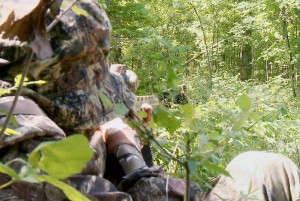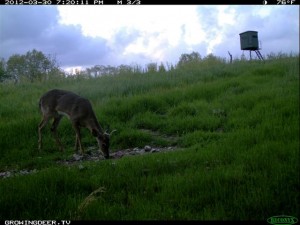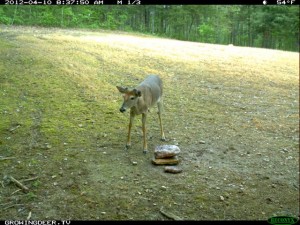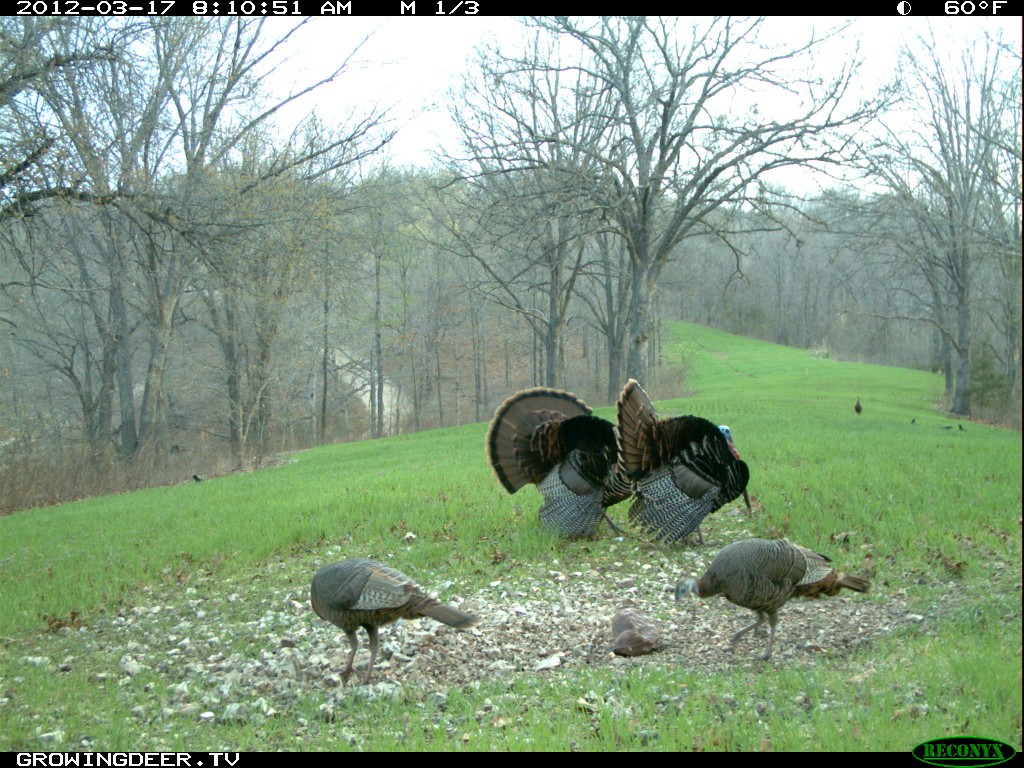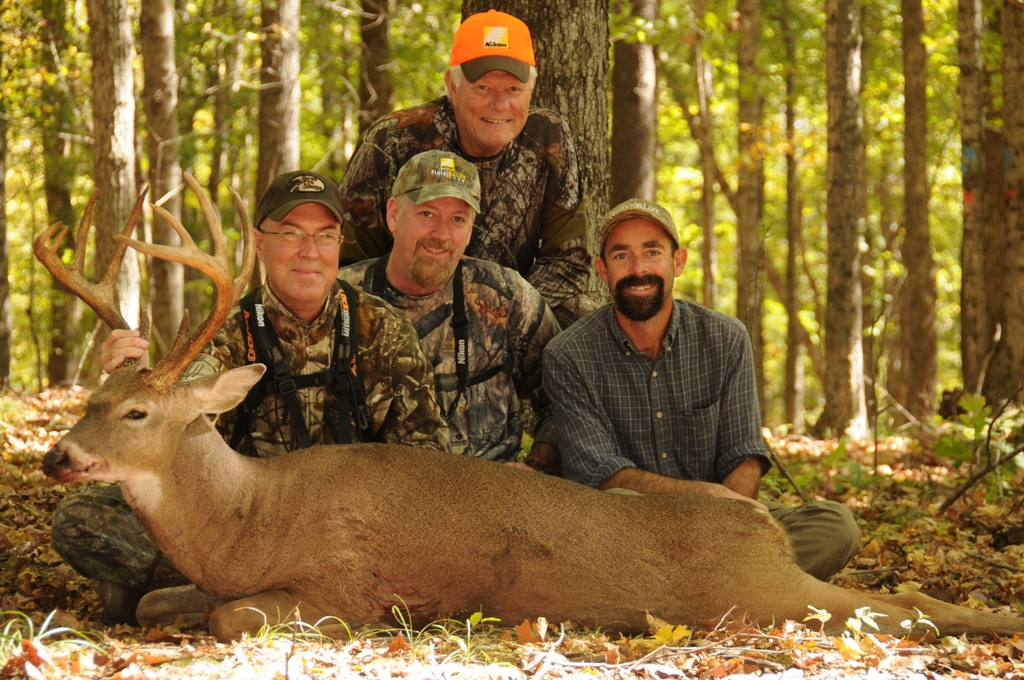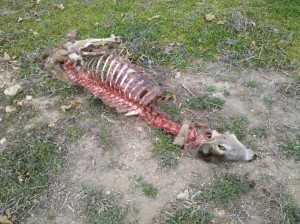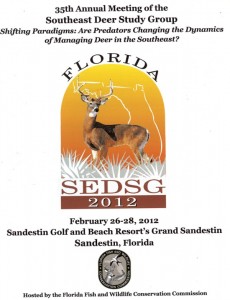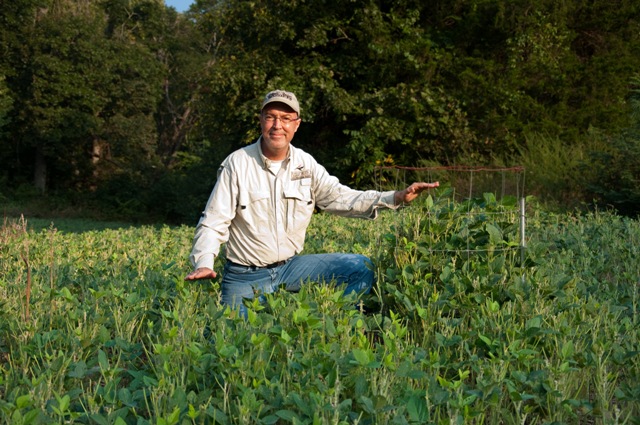Category: Hunting Blog
The Effect Of A Warmer Spring And The 2012 Turkey Season
It’s currently turkey season in many states. I realize it’s almost over in some and hasn’t started yet in others – but it is turkey season in most states!
The temperatures have been warmer than normal in most states so far this spring, as was the case throughout most of the winter. Many GrowingDeer.tv fans told me about seeing turkeys showing breeding behavior earlier than normal this year. That was followed by reports of folks finding turkey nests earlier than normal also.
We are just wrapping up the first week of turkey season in Missouri; the gobbler behavior is certainly different than normal for this time of year. This all fits as Missouri University reports that the winter of 2011-12 was the fifth warmest on record. Flowers bloomed earlier, folks were mowing their yards earlier, farmers were planting earlier, and turkeys began breeding earlier.
This means turkey hunters may need to change strategies a bit this year. Turkeys may be using different parts of their range this year as hens will be close to nesting habitat. Gobblers will be close to hens, so hunting near nesting habitat (cover from zero to at least one foot tall) is a good strategy. Hens typically come off their nest early during the morning and gobblers will court them. Gobblers will probably be more likely to come to calls after 9 am or so when most hens will be returning to their nest. Late morning hunts may be the most productive!
The antler cycle has been different this year also. Bucks throughout much of the whitetails’ range held their antlers several weeks longer than normal – with a few still holding antlers. However, currently most bucks are showing at least 2” of new antler growth. There is no doubt the relatively mild winter will have an impact on antler size during the 2012-13 season. However, the growing conditions this summer will likely have just as much, if not more impact on antler size this fall.
One thing is for sure, I’ll be watching antler development each week between now and deer season! I’ll keep you posted what I’m seeing in the field.
Growing Deer together,
Grant
Are You Seeing Antlers?
“Are you seeing antlers?” This time of year that question almost always means seeing bucks that have started growing a new set of antlers. However, that’s not the case this year. Due to the record warm winter and significantly lower than normal stress levels on deer, many bucks throughout the whitetails’ range are still holding antlers from the 2011-12 season.
At The Proving Grounds we got Reconyx images last week of bucks still holding antlers from last season and bucks that have shed and are starting to grow new antlers. I’ve even had a report of an image from Iowa of a buck that still has his antlers from last year and is starting to grow new antlers off to the side. That has happened before – but it is very odd.
I don’t know (and I doubt anyone does) what all this means as far as antler growth this summer. I strongly suspect the growing conditions this summer will be more of an influence on antler production more than the odd shedding pattern that is occurring. I’m very eager to see how antlers develop this summer! I would appreciate seeing trail camera images of bucks that haven’t shed as of today (April 13th). I’d also really appreciate any trail camera images of bucks that are growing their new antlers while still holding antlers from last year. (You can upload the images directly to my Facebook page.)
Odd years produce odd results. I’m eager to see how the average antler production during 2012 turns out!
Growing Deer (and learning) together,
Grant
Early Turkeys?
I’ve been driving/riding across South Dakota, Nebraska, and Missouri since before daylight. Adam and I have probably seen 50 gobblers strutting during this drive. We’ve crossed 100’s of miles in latitude, driven through row crop, pasture, national forest, and river bottom habitat types. We’ve seen fallow fields, planted fields, and farmers planting fields. The one constant has been that temperatures are much warmer than normal for this time of year and it appears that turkeys are about a month ahead of their normal mating season schedule.
Last weekend was youth season in Missouri. I took both Raleigh and Rae hunting with high expectations of a double harvest during the weekend. During the past few years, adult gobblers have readily responded to my calling and a jake decoy. Those hunts resulted with turkey in the deep fryer after Raleigh and Rae tagged their toms. Many state agencies schedule youth season early during the turkey mating season as during this time gobblers usually readily respond since most hens are not receptive to toms at this time.
That scenario wasn’t the case last weekend. Both mornings my daughters and I heard toms gobbling on the roost, and both mornings toms ended up responding to my calls. However, on both mornings the toms took a very long time to respond. They cautiously approached our decoys, but remained out of range, took a look and veered off. Their behavior was very odd for this time of year – but not the conditions…
The temperatures and development of vegetation are both approximately a month ahead of normal. Fellow hunters and biologists have recently shared with me they’ve seen turkey poults already this year in multiple states. It’s very early to see or hear reports of turkey poults. Heck, regular turkey season hasn’t opened yet in Missouri!
Missouri University reports that the winter of 2011-12 was the fifth warmest winter since they’ve been keeping records. No doubt the timing of mating, development of vegetation, etc., will be different than normal. The good news is that 2011-12 was only the fifth warmest winter on record. There have been warmer winters, many years ago, and turkeys, deer, and vegetation survived well.
Even with these conditions, I look forward to opening day. I’ll be evaluating the gobblers’ behavior and adjusting my hunting strategies accordingly. That’s a great thing about hunting – every year is different and every day in the woods offers an opportunity to learn and improve our hunting skills.
I’ll share what I learn and hope you join the GrowingDeer.tv Team and share back with us so we can all learn together.
Growing Deer (and learning) together,
Grant
Youth Turkey Season
Youth turkey season begins tomorrow in my home state of Missouri! I plan on taking my oldest daughter, Raleigh – 13, tomorrow morning and my younger daughter, Rae – 10, tomorrow afternoon. It’s legal to hunt turkeys from sunrise until sunset in Missouri during youth season, and only until 1pm during the regular season (starting in two weeks).
I’ve been using my Reconyx cameras in an effort to pattern turkeys. I’ve placed the cameras overlooking food plots that I know from past experience are areas where gobblers like to strut.
Using this technique, I have located two plots that turkeys are frequenting somewhat regularly. I enjoy cut and run turkey hunting, but not for taking my daughters, especially Rae. Patterning turkeys and using a ground blind is an outstanding technique and allows much more father/daughter time and conversations!
I think I’ve crossed another hurdle this year. Last year, a large gobbler hung up on Rae and I about 150 yards out (GDTV 73). That turkey stayed on the ridge for more than an hour! That’s a long time for any hunter to hold a shotgun – but close to impossible for a 9 year old. This isn’t as large of a feat if the hunter is sitting on the ground with his back to a tree. He can rest the gun on his knee and find a time to move it slightly as the tom approaches.
However, taking a gun from leaning in the corner of a blind to sticking out the window (about 2”) for a 9 year old can be tricky – especially after watching a strutter for more than an hour! This year I have a Caldwell DeadShot FieldPod. Simply stated, it’s a very light, tri-pod (stable) that holds both the front and back of the shotgun. I actually got if for me for long range predator hunting, but tried it yesterday with Rae’s 20 gauge and decided it was perfect for a youth hunt in a turkey blind.
I’ll share the results of using the Reconyx to pattern gobblers and hopefully how Raleigh and Rae liked the DeadShot FieldPod next week.
No matter what happens, I’m sure the time in the blind will be a trophy for my book!
Growing Deer (and children) together,
Grant
Pt. 10: Top 10 Recommendations for Managing Land to Yield Mature, Huntable Deer
Part 10: Putting it all Together
I wrote this series to address several questions recently posted on my Facebook page. The questions were timely as there is a huge interest in hunting mature bucks. Folks are realizing that to hunt mature bucks, mature bucks must exist. For example, hunting mature bucks on properties where a majority of the yearling bucks are harvested annually is very frustrating.
Therefore it’s very important to have realistic objectives based on a property’s recent buck harvest. For example, if there have been an average of three bucks harvested per square mile on the property and/or neighborhood where you are hunting, there won’t likely be many bucks reaching maturity on that property. The bottom line is there must be mature bucks present to be harvested. Obviously, the more mature bucks in the area the better the odds of having an encounter with one. A higher percentage of the total buck harvest is usually composed of mature bucks in states with a more restrictive bag limit for bucks. Kentucky and Kansas are good examples of states with a restrictive buck bag limit and a trend of producing great mature bucks annually.
This is simply a trend. I’m aware of individual properties in most states that produce great mature bucks. These landowners or deer management cooperatives usually establish more favorable deer harvest guidelines than imposed by the state’s regulations. This is to say that the grass is not always greener on the other side of the fence (or border).
Simply allowing bucks to reach maturity doesn’t mean they will express their full antler growth potential. Bucks need an excellent source of nutrition throughout their life to express their full antler growth potential – in addition to living to maturity. Even further, the better health (good food, limited stress) the buck’s dam was in has an impact on the buck’s health.
This means that simply significantly increasing the quality of a buck’s diet for a year or two won’t necessarily allow him to express his full potential. The overall health of a buck (or other critter) is substantially impacted by their development years. When Tracy and I purchased The Proving Grounds, it was a horribly overgrazed cattle ranch. We’ve now owned it nine+ years and spent a lot of time and resources improving the habitat. However, the five year old bucks that are currently on our property were most likely from does that were raised in very stressful conditions. To determine the true potential of bucks at The Proving Grounds will require maintaining quality habitat long enough for does to be born from does that were raised with access to quality food and limited stress. Those does will need to have fawns, and then allow those male fawns to reach maturity. Let’s consider this three generations of deer – or 12+ years.
This process can be short cut if the property is in an area where quality nutrition has never been a limited factor, and the only missing piece of the deer management puzzle is allowing bucks to reach maturity. In other words, the lower the quality of habitat, the longer it will take to allow the herd to express its full potential. However, such land usually costs much less than row crop land where good nutrition has been available year round for many years.
I really enjoy the process of managing and hunting for mature bucks. I like going on suitcase hunts – hunting properties that I show up for a week or so a year and my only management activity is deciding to pass or pull the trigger. However, my passion is growing and hunting mature bucks. If you share my passion, we’ll keep learning together.
Growing Deer together,
Grant
Pt. 9: Top 10 Recommendations for Managing Land to Yield Mature, Huntable Deer
Part 9: Predator Induced Stress
Last week I shared with you a summary of Dr. John Kilgo’s long-term research about the amount of fawn mortality primarily caused by coyotes to deer in South Carolina. The results were that 70% of the fawns were killed by predators before the first hunting season after they were born. At that rate of mortality, even without any harvest by hunters, deer populations will decrease. This problem is not everywhere yet. However the number of coyotes, bobcats, black bears, cougars/mountain lions, etc., is increasing rapidly in many areas.
Several of my fellow researchers besides Dr. Kilgo have reported similar findings of predator caused mortality on young deer and even adult deer. Predators are a significant factor on deer populations in many areas!
However, direct mortality is only part of the picture. Even healthy adult deer that are not as susceptible to being killed by predators still can suffer because of high predator populations. Great research on elk in Yellowstone National Park has shown that elk that haven’t been killed by wolves are averaging fewer calves per cow, lower body weights, and the males have smaller antlers on average than before wolves were reintroduced. How can this be? Fewer mouths competing for the same or more food should result in more calves per cow, heavier body weights, and larger antler for each age class.
The answer was found by comparing the levels of specific hormones in elk before they were exposed to wolves and then again five years after wolves had been released into Yellowstone. These hormones are produced and released in critters that are stressed. The levels of these hormones were several times higher in the elk after being exposed to wolves!
This is not surprising. The medical news is full of studies reporting how damaging stress is to human health. Dairy, beef, and even poultry farmers attempt to reduce stress in their stock so they will be more productive. The same is true with game animals. Being chased or even living where they need to be constantly vigilant to avoid predators results in increased stress.
Increases in the number of predator populations (increasing coyote, bobcat, bear, hog, etc.) certainly results in increased stress for several species of game animals.
In addition to reduced health caused by predator induced stress, there is another negative to allowing the predator population to increase significantly.
Deer and turkeys that are constantly vigilant against four-legged predators are also constantly vigilant against two-legged predators. It will likely be more difficult to observe game species on properties that have an abundance of coyotes and other predators. I’ve worked on a few properties that had an abundance of predators. We called and trapped to reduce the number of predators and the observation rate of mature whitetail bucks increased within weeks! These bucks didn’t mature into the population. It is doubtful they moved into the population. They simply became less vigilant.
To have more mature bucks to hunt, there must be more fawns recruited into the population. It’s noticeably easier to have encounters with mature bucks when they are less vigilant. Significantly reducing the number of predators will likely have a positive impact on deer herds. Due to increasing predator populations and decreasing numbers of trappers, predator management is rapidly becoming a significant part of deer and turkey management.
Growing Deer together,
Grant
Pt. 8: Top 10 Recommendations for Managing Land to Yield Mature, Huntable Deer
Part 8: Predators
The past seven entries for this blog have been on the subject of managing for and killing mature bucks. However, in recent years just following the play book for passing bucks and providing quality food, cover, and water may not yield the results you desire. Something has changed across much of the landscape.
It’s the number of predators. When I was a boy (I was born in 1961), coyotes were shot on sight by farmers (almost every farmer I knew always had a rifle in his truck). Raccoon pelts were bringing $50.00 +/- and anyone I knew that was any kind of hunter or outdoorsmen trapped and/or hunted raccoons as a source of additional income. Chicken hawks (any large hawk was called a chicken hawk) were also shot on sight. These actions didn’t cause any of these predators to go extinct.
I went off to college and was taught to feel sorry for predators. I was taught that predators were almost never an issue with game species. That might have been true then (although I had a hard time buying into the theory). I was also taught in college that all natural systems are very dynamic – always changing (I certainly have experienced and agree with that!). Whatever the theories and realities were, the current impact of predators on deer, turkey, quail and other game species are real and measureable!
This last statement is not simply my observations. I had a graduate student five years ago study the impacts of coyote and bobcats on fawn recruitment (fawns surviving until hunting season) on a private property in northern Alabama. Briefly summarized, the results were stunning! He monitored fawn recruitment during year one, then had a trapper remove many coyotes and bobcats from the 2,000 acre property during the following fawning season. During the second fawning season there was a 150+% increase in fawns at the same property as result of removing 20+ coyotes and 10 bobcats! It appeared the turkey and rabbit population also exploded!
When Cory VanGilder (the grad student) presented his resultsat the annual Southeast Deer Study Group Meeting, there wasn’t much excitement among the 100’s of scientists in attendance. Fast forward five years, I just returned from the 35th Southeast Deer Study Group Meeting. Just to give you a hint of the change in attitudes among some of my fellow deer biologists, the theme of the meeting this year was Shifting Paradigms: Are Predators Changing the Dynamics of Managing Deer in the Southeast? Twelve of the 35 presentations were on the subject of coyote predation on deer!
Several of the researchers reported results of fawn mortality documented by the use of vaginal transmitters (VITS). This technology allowed researchers to captures does after they’ve been bred and insert a transmitter in their vagina. The VIT is pushed out of the birth canal when the fawn is born and alerts the researchers by changing the frequency/tone of signal. Researchers can often find the birth site and/or fawn within four hours or less after birth.
Dr. John Kilgo, a talented researcher for the Forest Service, has years of such data. He and his staff have documented that in recent years, 70% of the fawns were killed by predators at their research site (a 300 square mile area in South Carolina) during the first few months after birth! 62% of the total mortality was due to coyotes!! This is not a guess or a theory. At this level of predation, even without any hunting mortality, deer populations will decrease rapidly in number and quality (more on the stress of predation next week).
John and his staff swab the kill site and use advanced techniques with genetic testing to confirm if the killer was a coyote, bobcat, domestic dog, etc. Using this technology, they can tell if it was a male or female predator, and if it was the same predator that killed a fawn ¼ mile or 10 miles way. John’s research is fascinating!
He ended his abstract by saying “I predict that this pressure (coyotes) will require significant changes in how deer populations are managed in the Southeast in the future, because coyotes are here to stay.”
I agree with John, but know from my student’s work and my experience that coyotes can be trapped and their impact on deer populations reduced. Trapping and calling coyotes are fun activities (GDTV 119). However, it requires time and effort. There is no easy method to significantly reduce coyote populations. Some managers will simply let their deer herds be significantly reduced by coyotes. I, and hopefully many others, will not sit by and watch deer populations be reduced significantly by predators. I will actively call and trap coyotes to keep their population in check so deer, turkey, and other game species can maintain a healthy population.
I enjoy hearing a coyote howl. However, I enjoy seeing and interacting with deer and turkeys more. When push comes to shove, I’ll be the deer’s best friend and the coyote’s worst enemy. How about you? Will you sit by and watch America’s favorite game species be reduced to the occasional rare sighting? Or will you join me in protecting the future of hunting?
The damage by coyotes and other predators to deer and other game species is not just direct mortality. Predators also can cause much stress to game species! Next week I’ll share more about this issue.
Growing (and protecting) Deer together,
Grant
Pt. 7: Top 10 Recommendations for Managing Land to Yield Mature, Huntable Deer
Part 7: Flat Ground – The Huntable Side
Last week I shared the advantages of flat ground to produce mature bucks. That discussion was more about the ability to produce quality forage, and therefore quality bucks (if they are allowed to mature). There is another substantial advantage to flat ground. It may be the best reason to seek a hunting property that is flat versus steep.
The huge advantage of hunting flat ground is that the wind seldom swirls where the topography is flat. The wind does change directions as fronts pass, etc., but it rarely swirls and certainly doesn’t swirl on a constant basis. Swirling winds are often caused by changes in topography. Changes in topography create eddies where the wind sinks and rises. Rapid changes of topography also create temperature gradients (warm air rises and cool air sinks). These temperature gradients cause thermals or air moving based on slope and temperature.
Deer move the most during dawn and dusk. There is more air movement due to thermals during these same time periods because this is when the temperature is changing the most. It may well be that in areas with steep topography, deer are the most active during dawn and dusk to take advantage of the swirling winds to aid their avoiding predators (2 and 4 legged). Swirling winds and thermals allow deer to detect predators from multiple directions – not just one (like what would occur in areas where the wind is typically out of one direction).
There can be some thermal action in flat country. However, the direction and duration of the thermals seem to be much more predictable compared to areas with steep topography.
Most hunters throughout the whitetails’ range are blessed enough to have access to hunt flat ground. My property is the opposite of flat. In fact, it changes elevation 350+ feet several times due to the ridges and creeks. To reduce the chance of being detected by a buck’s nose, I use a complete system of cleaning my gear and good personal hygiene, including doing laundry for better deer hunting. I use the natural Dead Down Wind products as they eliminate a wider spectrum of odors than most of the products that are created to only reduce odors created by bacteria. I also want to reduce odors on my gear and myself from lubricants and whatever else might alert bucks.
There are several advantages to hunting flat ground. These advantages include producing better quality forage so bucks can express more of their potential and being able to predict the prevailing wind direction while having fewer thermals. These are two huge advantages to any deer hunter.
Growing Deer together,
Grant
Pt. 6: Top 10 Recommendations for Managing Land to Yield Mature, Huntable Deer
Part 6: Flat Ground
I’ve been discussing how to manage land to produce mature and huntable bucks. It’s relatively easy to produce mature bucks. Simply don’t harvest them until they are 4+ years of age. I define mature for whitetail bucks as being four years old or older because by that age most bucks have expressed 90+% of their antler growth potential.
In this blog series I’ve also discussed management strategies which allow bucks to express their antler growth potential. Just because a buck is allowed to live until he is 4+ years of age doesn’t mean he will produce antlers to his full genetic potential. If he hasn’t had access to a quality diet throughout his life and experienced minimal stress, he will not produce antlers as large as his genetic potential.
Now that we discussed several aspects of managing deer so they can express their full genetic potential, I’d like to discuss how to harvest mature bucks. Last week I shared that I’d found several sheds in bottlenecks or pinch points while laying out a habitat management plan on a property in central Missouri.
I really enjoy finding sheds. However, finding where a mature buck has been is not the same as being where a mature buck is – within shooting range! Predicting where a mature buck will be during daylight hours and being there at the same time – especially accomplishing this on a year after year basis – requires a lot of skill and preparation.
Wonder why so many whitetail hunters go to areas that produce commercial row crops year after year? If you look at a map of the whitetail’s range, the portion of the area that produces commercial row crops is a relatively small portion of the whitetails range. Yet, the majority of Boone and Crocket and Pope and Young entries come from the areas where commercial crops are produced.
There are two simple reasons and they both relate to flat ground. Flat ground – especially in the Midwest is almost always better quality soil compared to where the topography is steep and the topsoil has been eroded. However, years and years of producing and harvesting commercial crops have significantly reduced the amount of nutrients and beneficial bacteria in the soil. Without adding fertilizer and beneficial microbes back to the soil, it would not be nearly as productive. These elements are rarely added back to the soil unless it is commercially farmed. Hence they are rarely applied to areas with steep topography.
My property, The Proving Grounds, is a perfect example. It has very steep terrain and was extremely eroded from exceedingly poor timber harvest and agricultural practices decades ago. There literally was no topsoil only rock – literally – only rock. I never disk a plot at my place because it would only shuffle rocks around and cause erosion of the limited amount of organic matter that is present.
However, by adding poultry litter that has been composted with beneficial, soil building bacteria added (Antler Dirt) I’ve significantly improved the quality of crops produced in my food plots. I can now grow quality crops, even on the rocky soil where I never disk! Remember that quality forage and grain crops are only nutrient transfer agents. They serve to transfer nutrients from the soil and air (air is roughly 78% nitrogen – capture that and never pay for nitrogen again!) and transfer those nutrients to deer and other plant consumers.
Some plants are better at capturing nutrients and transferring to consumers (deer, cattle, humans) than others. Those plants typically are the crops grown in commercial ag – to feed humans (and deer). Oak trees transfer nutrients – but the vast majority of the nutrients they transfer are tied up in the wood or the structure of the tree.
Soybeans also transfer nutrients but a much higher percentage of the nutrients they transfer from the soil and air are deposited in the soybean leaves and eventually the soybean pods. Deer readily consume soybean leaves and pods. Deer rarely consume the trunks of oak trees – and never express their full antler growth potential when oak leaves and acorns are most of their diet. This is a primary reason bucks of the same age class living where soybeans are commonly grown will have larger antlers compared to bucks living in areas that are primarily forested.
Some of you are already yelling “acorns.” Acorns are much lower in nutrient content than soybean leaves or pods – there is no comparison between the nutritional quality of acorns and soybeans – or the antlers produced by bucks that primarily consume either crop.
So, if you want to hunt mature deer that have expressed most of their antler growth potential, you need to hunt where the soil has plenty of nutrients and plants that efficiently transfer those nutrients from the soil and air to deer. This can be in regions were commercial crops are grown (flat land), or where quality food plots are maintained.
For example, there isn’t a commercial soybean or corn field for many miles from my property (The Proving Grounds). However, over the years, I’ve converted the few flat spots among the hills where I live to well fertilized food plots and usually plant Eagle Seed forage soybeans. The results have been more than pleasing! My family and I have been blessed to produce and harvest several large, mature bucks.
If your objective is to harvest mature bucks with large antlers, you can go to flat, crop producing ground, or grow the same crops where you hunt. Big antlers start in the dirt – and it usually requires well fertilized flat dirt to grow good nutrient transfer agents (crops like soybeans) to allow bucks to produce their best antlers!
There is another HUGE advantage to managing and hunting deer where the land is flat. I’ll discuss that next week.
Growing Deer together,
Grant
Pt. 5: Top 10 Recommendations for Managing Land to Yield Mature, Huntable Deer
Part 5: Bottlenecks
Yesterday I toured a property in central Missouri with the mission of helping the landowner produce more mature bucks and increase his and his guests’ odds of harvesting them. My comments to the landowner were directly in line with the past four blog entries in this series. We talked about the age structure of the herd on his property, planned several additional feeding and hunting food plots to improve the quantity of quality forage available to the herd, and reviewed the existing cover.
While touring this property four of us found about 20 sheds!
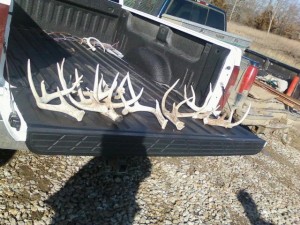
Shed antlers found on the property
Some of these sheds, including the larger ones, were found in bottlenecks.What are bottlenecks? They are physical barriers that limit deer movement to a known and relatively small area. You might call these features pinch points, funnels, etc. Where I was working yesterday, there were several strip pits and dump piles. Strip pits (at least at this property) are about 30’ deep by 150’ wide trenches where coal was mined decades ago. These are now filled with water and are fishing lakes. The dirt from these pits was typically “dumped” close by after the coal was removed.
The dumps are steep, rough, and tough to transverse for man or beast. Deer will certainly go in the dumps and frequently use them as cover, etc., but prefer not to travel through dumps when moving from point A to point B. There were several places where the dumps were within 40-50 yards from the end of a strip pit that was several hundred yards long. The flat ground in between the dumps and the pits created great bottlenecks!
Typically, the longer the barrier (dumps or strip pits on this property) the more utilized the bottleneck. The trails, rubs, etc., we found near the bottlenecks on this property were enough to excite any hunter! I was so excited about the amount of buck sign in these bottlenecks I was ready to begin hanging stands!
My property is just the opposite. It is large patches of hardwoods with a few food plots mixed in. It is very tough to pattern where bucks will travel on my property with any certainty. This is called homogenous habitat. Crop land in the Midwest is full of bottlenecks. Wide open crop fields, especially after the crops have been harvested, tend to funnel buck movement into narrow wood lots, or CRP fields. Where the whitetails move is much more predictable in those areas compared to land that is basically one habitat type (like all woods).
However, bottlenecks can be created! Depending on where I’m working and what’s available, I’ve used discarded round bales of hay, snow fence, etc. Sometimes low value trees can be felled to make bottlenecks. I don’t like this approach as well as others because trees tend to decay rapidly and it’s tough to fell trees in a line with no gaps.
If you are like me and primarily hunt areas where there are very few natural bottlenecks, consider using a readily available resource and creating some. Consider how to approach the stand, wind direction, etc. It’s often easier to grow mature bucks than it is to harvest mature bucks. Creating a bottleneck is an outstanding tool to reap the benefits of your deer management efforts.
Growing (and killing) Deer together,
Grant



